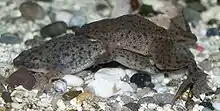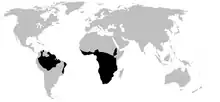| Pipidae Temporal range: | |
|---|---|
 | |
| African dwarf frog | |
| Scientific classification | |
| Domain: | Eukaryota |
| Kingdom: | Animalia |
| Phylum: | Chordata |
| Class: | Amphibia |
| Order: | Anura |
| Clade: | Pipoidea |
| Clade: | Pipimorpha |
| Family: | Pipidae Gray 1825 |
 | |
| Distribution of Pipidae in black | |
The Pipidae are a family of primitive, tongueless frogs. There are 41 species in the family, found in tropical South America (genus Pipa) and sub-Saharan Africa (the three other genera).
Description
Pipid frogs are highly aquatic and have numerous morphological modifications befitting their habitat. For example, the feet are completely webbed, the body is flattened, and a lateral line system is present in adults.[1] In addition, pipids possess highly modified ears for producing and receiving sound under water. They lack a tongue or vocal cords, instead having bony rods in the larynx that help produce sound. They range from 4 to 19 cm (1.6 to 7.5 in) in body length.[2]
Taxonomy
Family Pipidae Gray 1825[3]
- Hymenochirus Boulenger 1896 - dwarf clawed frogs (4 species)
- Pipa Laurenti 1768 - Surinam toads (7 species)
- Pseudhymenochirus Chabanaud 1920 - Merlin's dwarf gray frog or Merlin's clawed frog (1 species)
- Xenopus Wagler 1827 - clawed frogs (29 species)[4]
Fossil record
The oldest fossil records of frogs more closely related to pipid frogs than to other extant frog families (Pipimorpha) extends into the Early Cretaceous. The oldest known crown group pipids are Oumtkoutia and Pachycentrata from the Upper Cretaceous of Morocco and Niger, respectively.[5]
Included taxa after A. M. Aranciaga Rolando et al. 2019[6]
- †Oumtkoutia Rage and Dutheil 2008 Aoufous Formation, Morocco, Late Cretaceous (Cenomanian)
- †Llankibatrachus Báez and Pugener 2003 Huitrera Formation, Argentina, Eocene
- †Pachycentrata Báez and Rage 2004 (= Pachybatrachus Báez and Rage, 1998) In Beceten Formation, Niger, Late Cretaceous (Coniacian)
- †"Shelania" laurenti Baez and Pugener 1998 Argentina, Eocene
- "Xenopus" romeri Estes 1975 Companhia National de Cimento Portland Quarry, Brazil, Paleocene
- †Eoxenopoides Haughton 1931 South Africa, Late Cretaceous (Maastrichtian)
- †Singidella Báez and Harrison 2005 Tanzania, Eocene
References
- ↑ "AmphibiaWeb: Pipidae". Berkeley, California: AmphibiaWeb. Retrieved 2009-10-25.
- ↑ Zweifel, Richard G. (1998). Cogger, H.G.; Zweifel, R.G. (eds.). Encyclopedia of Reptiles and Amphibians. San Diego: Academic Press. pp. 86–87. ISBN 0-12-178560-2.
- ↑ Pipidae at the Amphibian Species of the World 6.0 - AMNH
- ↑ Evans et al., 2015
- ↑ Gómez, Raúl O. (July 2016). "A new pipid frog from the Upper Cretaceous of Patagonia and early evolution of crown-group Pipidae". Cretaceous Research. 62: 52–64. doi:10.1016/j.cretres.2016.02.006.
- ↑ Rolando, Alexis M. Aranciaga; Agnolin, Federico L.; Corsolini, Julián (October 2019). "A new pipoid frog (Anura, Pipimorpha) from the Paleogene of Patagonia. Paleobiogeographical implications". Comptes Rendus Palevol. 18 (7): 725–734. doi:10.1016/j.crpv.2019.04.003. S2CID 197581931.
Bibliography
- Gómez, Raúl O (2016). "A new pipid frog from the Upper Cretaceous of Patagonia and early evolution of crown-group Pipidae". Cretaceous Research. 62: 52–64. doi:10.1016/j.cretres.2016.02.006. doi:10.1016/j.cretres.2016.02.006
- Antoine, P.; Abello, J.A.; Adnet, S.; Altamirano Sierra, A.J.; Baby, P.; Billet, G.; Boivin, M.; Calderón, Y.; Candela, A.R.; J. Chabain; F. Corfu; D. A. Croft; M. Ganerød; C. Jaramillo; S. Klaus; L. Marivaux; R. E. Navarrete; M. J. Orliac; F. Parra; M. E. Pérez; F. Pujos; J. Rage; Anthony Ravel; Céline Robinet; Martin Roddaz; Julia Victoria Tejada Lara; Jorge Vélez-Juarbe; Frank P. Wesselingh; Rodolfo Salas Gismondi (2016). "A 60-million-year Cenozoic history of western Amazonian ecosystems in Contamana, eastern Peru" (PDF). Gondwana Research. 31: 30–59. doi:10.1016/j.gr.2015.11.001. Retrieved 2020-03-19.
- Ben J. Evans; et al. (2015). "Genetics, morphology, advertisement calls, and historical records distinguish six new polyploid species of African Clawed Frog (Xenopus, Pipidae) from West and Central Africa". PLoS One. 10 (12): 1–51. doi:10.1371/journal.pone.0142823. PMC 4682732. PMID 26672747.
- Gelfo, J.N.; Ortiz Jaureguizar, E.; Rougier, G.W. (2007). "New remains and species of the 'condylarth' genus Escribania (Mammalia: Didolodontidae) from the Palaeocene of Patagonia, Argentina". Earth and Environmental Science Transactions of the Royal Society of Edinburgh. 98 (2): 127–138. doi:10.1017/S1755691007006081. S2CID 86564613. Retrieved 2020-03-19.
- Head, Jason J.; Sánchez Villagra, Marcelo R.; Aguilera, Orangel (2006). "Fossil snakes from the Neogene of Venezuela (Falcon State)". Journal of Systematic Palaeontology. 4 (3): 233–240. doi:10.1017/S1477201906001866. S2CID 140683831. Retrieved 2020-03-19.
- Gissi, Carmela; San Mauro, Diego; Pesole, Graziano; Zardoya, Rafael (2006). "Mitochondrial phylogeny of Anura (Amphibia): A case study of congruent phylogenetic reconstruction using amino acid and nucleotide characters". Gene. 366 (2): 228–237. doi:10.1016/j.gene.2005.07.034. PMID 16307849. PMID 16307849 doi:10.1016/j.gene.2005.07.034
- Roelants, Kim; Bossuyt, Franky (2005). "Archaeobatrachian paraphyly and pangaean diversification of crown-group frogs". Systematic Biology. 54 (1): 111–126. doi:10.1080/10635150590905894. PMID 15805014. S2CID 10677785. doi:10.1080/10635150590905894 PMID 15805014
- San Mauro, Diego; Vences, Miguel; Alcobendas, Marina; Rafael, Zardoya; Meyer, Axel (2005). "Initial diversification of living amphibians predated the breakup of Pangaea" (PDF). American Naturalist. 165 (5): 590–599. doi:10.1086/429523. PMID 15795855. Retrieved 2020-03-19. doi:10.1086/429523 PMID 15795855
- Báez, A.M.; Pugener, L.A. (2003). "Ontogeny of a new Palaeogene pipid frog from southern South America and xenopodinomorph evolution" (PDF). Zoological Journal of the Linnean Society. 139 (3): 439–476. doi:10.1046/j.1096-3642.2003.00085.x. S2CID 85039976. Retrieved 2020-03-19.
- Báez, A.M.; Trueb, L. (1997). "Redescription of the Paleogene Shelania pascuali from Patagonia and its bearing on the relationships of fossil and Recent pipoid frogs" (PDF). Natural History Museum, University of Kansas. pp. 1–41. Retrieved 2019-03-01.
- A.M. Baez, A.M (1987). "The Late Cretaceous fauna of Los Alamitos, Patagonia, Argentina part III — anurans". Revista del Museo Argentina de Ciencias Naturales "Bernardino Rivadavia" e Instituto Nacional de Investigacion de las Ciencias Naturales: Paleontología. 3: 121–130. Retrieved 2020-03-19.
- Estes, R.; Wake, M.H. (1972). "The first fossil record of caecilian amphibians". Nature. 239 (5369): 228–231. doi:10.1038/239228b0. S2CID 4260251.